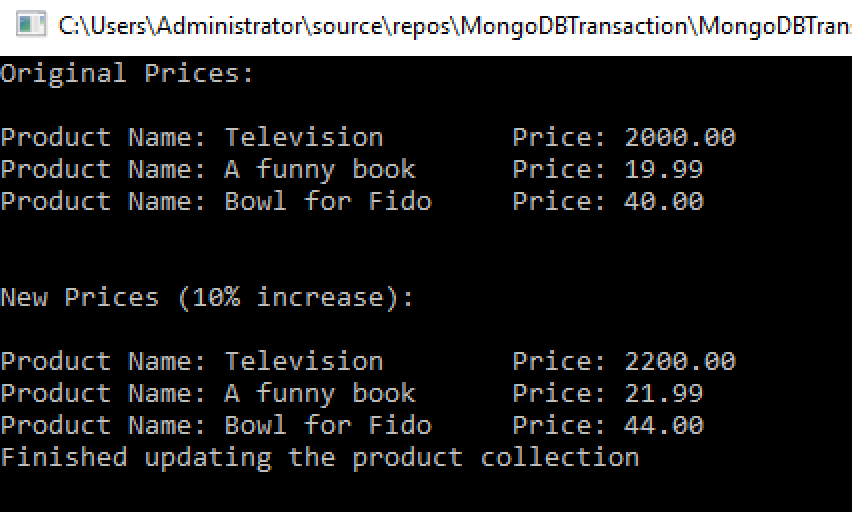C# applications connected to a MongoDB database use the MongoDB .NET driver. To add the .NET driver to your Visual Studio Application, in the NuGet Package Manager, search for "MongoDB".

Make sure you choose the latest version (>=2.7) of the driver, and press Install.
Prior to MongoDB version 4.0, MongoDB was transactionally consistent at the document level. These existing atomic single-document operations provide the transaction semantics to meet the data integrity needs of the majority of applications. This is because the flexibility of the document model allows developers to easily embed related data for an entity as arrays and sub-documents within a single, rich document. That said, there are some cases where splitting the content into two or more collections would be appropriate, and for these cases, multi-document ACID transactions makes it easier than ever for developers to address the full spectrum of use cases with MongoDB. For a deeper discussion on MongoDB document model design, including how to represent one-to-many and many-to-many relationships, check out this article on data model design.
In the following code we will create a Product object and perform a MongoDB transaction that will insert some sample data into MongoDB then update the prices for all products by 10%.
1 using MongoDB.Bson; 2 using MongoDB.Bson.Serialization.Attributes; 3 using MongoDB.Driver; 4 using System; 5 using System.Threading.Tasks; 6 7 namespace MongoDBTransaction 8 { 9 public static class Program 10 { 11 public class Product 12 { 13 [] 14 public ObjectId Id { get; set; } 15 [] 16 public int SKU { get; set; } 17 [] 18 public string Description { get; set; } 19 [] 20 public Double Price { get; set; } 21 } 22 23 // replace with your connection string if it is different 24 const string MongoDBConnectionString = "mongodb://localhost"; 25 26 public static async Task Main(string[] args) 27 { 28 if (!await UpdateProductsAsync()) { Environment.Exit(1); } 29 Console.WriteLine("Finished updating the product collection"); 30 Console.ReadKey(); 31 } 32 33 private static async Task<bool> UpdateProductsAsync() 34 { 35 // Create client connection to our MongoDB database 36 var client = new MongoClient(MongoDBConnectionString); 37 38 // Create the collection object that represents the "products" collection 39 var database = client.GetDatabase("MongoDBStore"); 40 var products = database.GetCollection<Product>("products"); 41 42 // Clean up the collection if there is data in there 43 await database.DropCollectionAsync("products"); 44 45 // collections can't be created inside a transaction so create it first 46 await database.CreateCollectionAsync("products"); 47 48 // Create a session object that is used when leveraging transactions 49 using (var session = await client.StartSessionAsync()) 50 { 51 // Begin transaction 52 session.StartTransaction(); 53 54 try 55 { 56 // Create some sample data 57 var tv = new Product { Description = "Television", 58 SKU = 4001, 59 Price = 2000 }; 60 var book = new Product { Description = "A funny book", 61 SKU = 43221, 62 Price = 19.99 }; 63 var dogBowl = new Product { Description = "Bowl for Fido", 64 SKU = 123, 65 Price = 40.00 }; 66 67 // Insert the sample data 68 await products.InsertOneAsync(session, tv); 69 await products.InsertOneAsync(session, book); 70 await products.InsertOneAsync(session, dogBowl); 71 72 var resultsBeforeUpdates = await products 73 .Find<Product>(session, Builders<Product>.Filter.Empty) 74 .ToListAsync(); 75 Console.WriteLine("Original Prices:\n"); 76 foreach (Product d in resultsBeforeUpdates) 77 { 78 Console.WriteLine( 79 String.Format("Product Name: {0}\tPrice: {1:0.00}", 80 d.Description, d.Price) 81 ); 82 } 83 84 // Increase all the prices by 10% for all products 85 var update = new UpdateDefinitionBuilder<Product>() 86 .Mul<Double>(r => r.Price, 1.1); 87 await products.UpdateManyAsync(session, 88 Builders<Product>.Filter.Empty, 89 update); //,options); 90 91 // Made it here without error? Let's commit the transaction 92 await session.CommitTransactionAsync(); 93 } 94 catch (Exception e) 95 { 96 Console.WriteLine("Error writing to MongoDB: " + e.Message); 97 await session.AbortTransactionAsync(); 98 return false; 99 } 100 101 // Let's print the new results to the console 102 Console.WriteLine("\n\nNew Prices (10% increase):\n"); 103 var resultsAfterCommit = await products 104 .Find<Product>(session, Builders<Product>.Filter.Empty) 105 .ToListAsync(); 106 foreach (Product d in resultsAfterCommit) 107 { 108 Console.WriteLine( 109 String.Format("Product Name: {0}\tPrice: {1:0.00}", 110 d.Description, d.Price) 111 ); 112 } 113 114 return true; 115 } 116 } 117 } 118 }
Source Code available on Gist. Successful execution yields the following:

#Key points:
- You don't have to match class properties to JSON objects - just define a class object and insert it directly into the database. There is no need for an Object Relational Mapper (ORM) layer.
- MongoDB transactions use snapshot isolation meaning only the client involved in the transactional session sees any changes until such time as the transaction is committed.
- The MongoDB .NET Driver makes it easy to leverage transactions and leverage LINQ based syntax for queries.
Additional information about using C# and the .NET driver can be found in the C# and .NET MongoDB Driver documentation.
